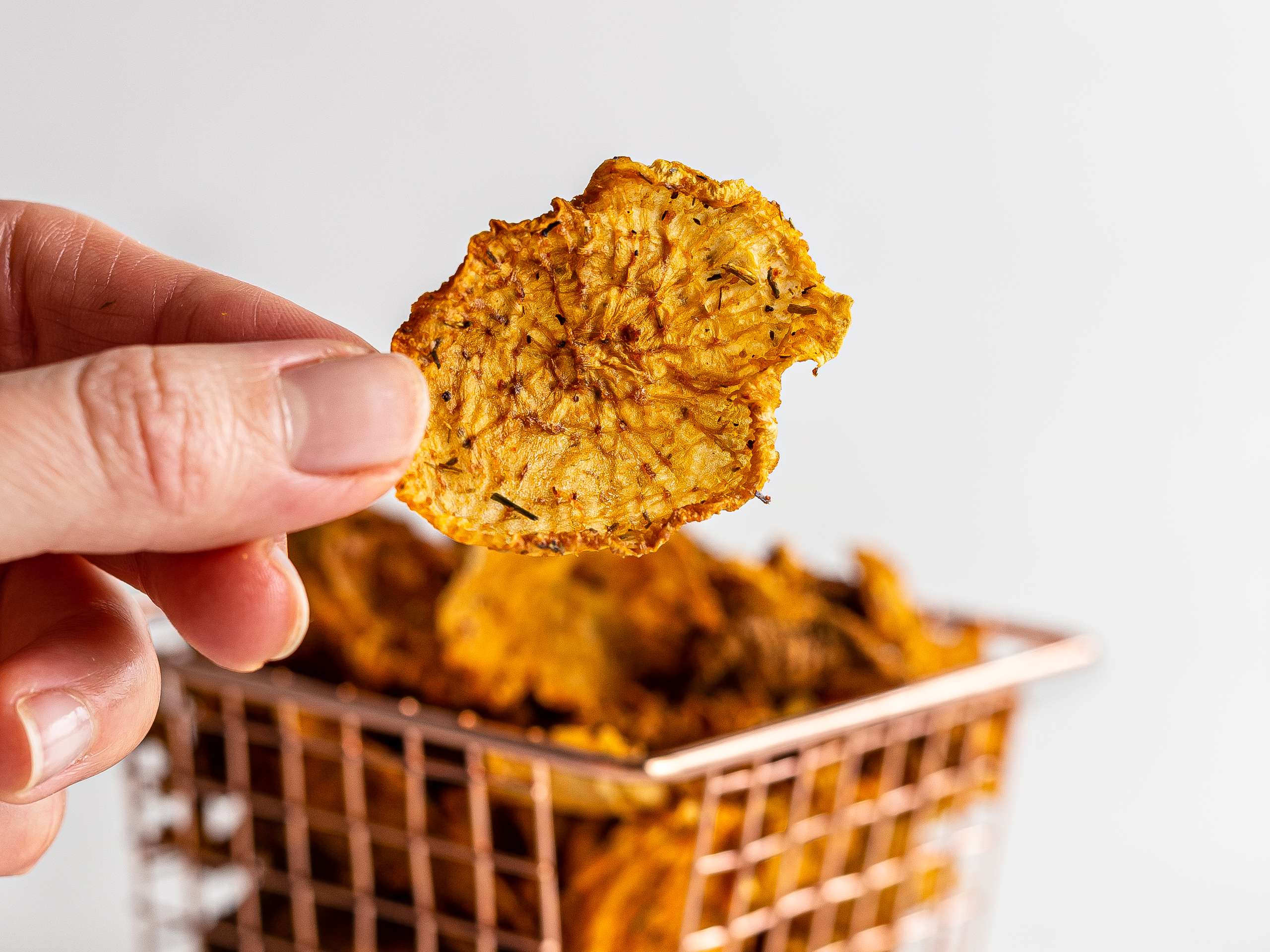Fancy crispy chips but don’t want all those fats and calories? Then check out our Baked Daikon Chips, with zero fats And 1/3 the calories of classic fried potato chips.
Making daikon chips is super easy. All you need is daikon, some spices and an oven! We used thyme, garlic powder and paprika. It’s a delicious blend that pairs beautifully with the subtle flavor of Daikon. Feel free to use any other spice mix you like!
Did you know that 100 grams of daikon has only 18 calories? This is mainly because this root has a water content of almost 95%. For this reason, fry daikon will not work. You’ll burn it before it gets crispy. Instead we will drain it by slow baking in the oven.
Baking the radish chips instead of frying them is great because we get rid of most of the extra calories you get from potato chips. By comparing the calories from plain potatoes to those from a bag of potato chips, they conclude that frying oil accounts for about 82% of the calories. Say no to that!
Instead, here’s what you get from a serving of homemade daikon chips (25 grams):
-
Zero grams of fat
-
5 grams of fibers
-
5 grams net carbs
-
50 calories
Basically, these chips are a weight loss dream: they have very few calories, no fat at all and one serving is enough 25% RDI of fibers. Additionally, the low net carb count makes it suitable for the keto diet. And of course, these daikon chips are vegan and gluten-free.
Ready for some crunch? Let’s begin!
NOTE: Standard ingredients make 50g (1.7 oz) of oven baked daikon chips and one serving is 25g (0.8 oz) of chips.
frequently asked Questions
Is Daikon low carb?
By weight, daikon radish has fewer carbohydrates than white potatoes. A 100 gram serving of Daikon has only 17 calories and 3.4 grams of carbohydrates. That means almost five times fewer calories and carbohydrates compared to potatoes.
Additionally, among the 3.4 grams of carbs in Daikon, there are 1.6 grams of indigestible fiber, meaning the net carb count is 1.8 grams. The net carbs are those that are actually absorbed and thus affect the total calorie count.
The ketogenic diet allows for between 10% and 20% of daily calories from carbohydrates, which means 40g of carbohydrates in a 2000 calorie diet[1]. Since a 25g serving of Daikon chips provides 5.4 grams of net carbs, it’s safe to say that you can enjoy this tasty snack as part of a ketogenic regime.
How do you make vegetable chips crispy?
Homemade veggie chips are a great way to add more veggies to your diet and reduce your consumption of high-fat, highly-processed foods.
Here we’ve listed a few basic tricks you should know to bake super crispy veggie chips from scratch:
-
Cut the chips thinly and evenly. Use a mandoline or sharp knife to cut into wafer-thin chips about 2-3mm thick. Also make sure the thickness of the chip is consistent throughout, or you’ll end up with a burnt side and a soggy side.
-
Rinse off starch. If you use starchy vegetables like squash or potatoes, be sure to wash off excess starch. You can do this by submerging the chips in a bowl of cold water and then draining them well.
-
pat dry. Since excess moisture can soak your veggie chips, we recommend patting them dry with paper towels or a dishcloth.
-
Bake slowly. If you cook the vegetable chips at a high temperature, they will burn before they have a chance to crisp. Therefore, it is important to bake them at a very low temperature, around 120°C (250°F) for 2 to 3 hours.
-
Cool evenly. Once the chips are ready, you must immediately place them on a grid to allow for even airflow. Otherwise, they will get soaked from the moisture trapped underneath. Once cool, store them in an airtight glass or tin container to lock in the crispiness.
Do radishes need to be peeled?
Whether you leave the radish skin on or not depends on the type of recipe you are preparing. If you’re using daikon in a soup or liquid-based dish, we recommend peeling the skin as it doesn’t taste good when cooked.
If you’re making a skillet or oven-baked fries instead, leave the skin on. Because the peel is high in fiber, it will provide crispier results and also double your fiber intake.
For our Baked Daikon Chips recipe, we left the skin on and got amazingly crispy results.
Are Vegetable Chips Healthier Than Potato Chips?
What makes one type of chip healthier than another is the method of preparation and the ingredients used.
Store-bought chips, either potato- or vegetable-based, fried or baked, are still relatively high in fat and salt. Being heavily processed, they rely on fats and salt to increase palatability and shelf life.
Homemade, oven-baked chips, on the other hand, are the healthiest types of chips.
This is because you can make them from scratch and have complete control over the amount of salt and fat used.
Baking the chips instead of frying them can drastically reduce the fats. But you can even make them fat-free like we did in our daikon chips recipe. Seasoning them with lots of spices, little or no salt, gives you super tasty chips with no added oil.
Prepared this way, both vegetable and potato chips make a healthy snack that you can enjoy without a guilty conscience. Vegetable-based chips like kale or radish chips are an even healthier option if you’re on a strict diet or ketogenic regime, as they’re lower in carbs and calories. For example, a 25g serving of our Daikon chips has only 50 calories and 5 grams of sugar, yet contains 20% of your RDI for fiber.

